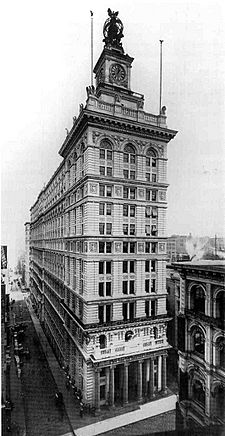Former New York Life Insurance Company Building facts for kids
|
Former New York Life Insurance
Company Building aka Clock Tower Building 346 Broadway |
|

the building after Hatch's and McKim, Mead & White's extension and redesign
|
|
| Location | 346 Broadway, New York, New York |
|---|---|
| Built | 1894 |
| Architect | Stephen D. Hatch; McKim, Mead & White |
| Architectural style | Late 19th And 20th Century Revivals |
| NRHP reference No. | 82003376 |
Quick facts for kids Significant dates |
|
| Added to NRHP | June 28, 1982 |
The Former New York Life Insurance Company Building, also known as the Clock Tower Building, is a structure located at 346 Broadway (with a secondary address of 108 Leonard Street) between Catherine Lane and Leonard Street, in Tribeca, Manhattan, New York City. Constructed in two stages, from 1868 to 1870 and from 1894 to 1899, it is a New York City Landmark and is listed on the U.S. National Register of Historic Places.
History
Office building
The New York Life Insurance Company's headquarters building was originally built in 1868-1870. It needed to be expanded eastward to Lafayette Street and Stephen Decatur Hatch was engaged for the job. Hatch designed the extension in 1894, but died before construction could be completed. The firm of McKim, Mead & White took over the work, and completed the extension in 1898, following Hatch's design. The company then decided to replace the original building as well, and McKim, Mead & White provided an Italian Renaissance Revival style "palazzo-like" design with a clock tower whose clock was manufactured and installed by the E. Howard Clock Company.
The building's prominent clocktower was topped with 33-foot tall, eight ton, sculpture made by Philip Martiny, who studied under Augustus Saint-Gaudens. The piece consisted of four, 11-foot tall, crouching figures of Atlas, on whose shoulders rested a 15-foot diameter hollow globe, which was topped off with a 7-foot-tall eagle. The gigantic statue was removed in the late 1940s and has been lost ever since.
New York Life left for the New York Life Building on Madison Square Park in 1928. In 1967, the City of New York acquired the building and moved several city agencies along with the Criminal Court, Summons Part, into the building. The building was added to the National Register of Historic Places in 1982, and the exterior, interior and historic 1895 E. Howard & Co. No. 4 tower clock mechanism (and connecting components) were all designated New York City landmarks in 1987 by the New York City Landmarks Preservation Commission. The building is also included in the AIA Guide to New York City in which the clock is described as a "wonderful Classical clock overlooking Broadway."
Residential/hotel use
In January 2013, the City of New York sold the building to developers Elad Group and the Peebles Corporation for $160 million.
In 2014, the Elad Group and Peebles Corporation began construction to convert the landmark building into a boutique hotel and private apartment condominiums. The clock was stopped at 10:25 am sometime after March 2015. The clock faces were to be preserved and electrified, but the landmarked, 1895 E. Howard clock mechanism (the largest clock mechanism in the United States) was to be decommissioned and removed. The New York Landmarks Preservation Commission granted a Certificate of Appropriateness, approving plans to close off the tower to the public and to allow the developers to destroy the clock.
Opponents, including Save America's Clock, the Historic Districts Council, and the Tribeca Trust filed an Article 78 proceeding in New York Supreme Court to prevent the conversion of the clock tower into a private residence and to save the clock. The reasons cited are that the clock tower has always been open to the public and that the clock mechanism is one of city's (and the nation's) few remaining mechanical clocks. Moreover, the clock mechanism itself is designated as a landmark. Since 1979, NYC Clock Master, Marvin Schneider and later his assistant, Forest Markowitz, have wound the clock on a weekly basis.
On March 31, 2016, Justice Lynn R. Kotler, of New York State Supreme Court ruled in favor of the Appellants and revoked the New York Landmarks Preservation Commission's Certificate of Appropriateness. According to the ruling, the Landmarks Preservation Commission has the authority to require the building owners to maintain the mechanical mechanism, and to issue a violation if the clock is transitioned to electrical workings. The case was heard by the Appellate Division of the Supreme Court, First Judicial Department on February 23, 2017. On November 30, 2017, the Appellate Court, in a 3-2 decision, upheld the lower court's ruling against the developers and the City of New York. The appellate decision affirmed the lower court's decision to prevent of the developers from electrifying or removing the landmarked clock and closing off the landmark clock tower from the public. The developers and the City of New York have filed another appeal in the New York Court of Appeals.
Restoration of the historic exteriors by New York firm HLZA included cleaning the marble, replacing damaged portions of the roof parapet, and restoring the 7,000-pound sculptural eagles perched on the roof.
See also
 In Spanish: Clock Tower Building para niños
In Spanish: Clock Tower Building para niños


